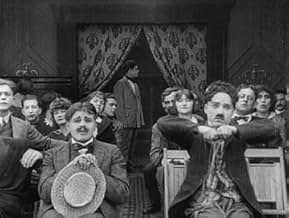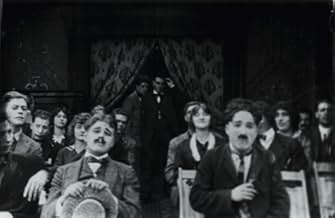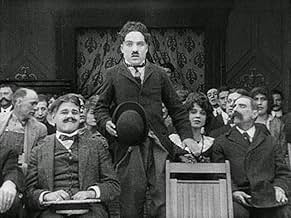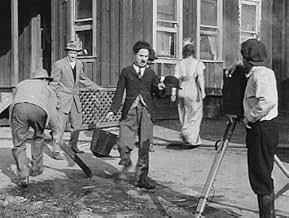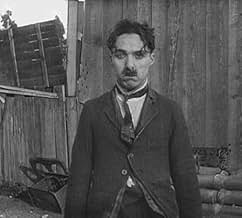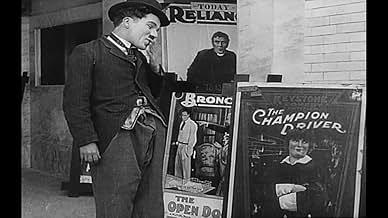IMDb RATING
5.6/10
1.8K
YOUR RATING
Charlie attempts to meet his favorite movie actress at the Keystone Studio, but does not win friends there.Charlie attempts to meet his favorite movie actress at the Keystone Studio, but does not win friends there.Charlie attempts to meet his favorite movie actress at the Keystone Studio, but does not win friends there.
- Director
- Writers
- Stars
Dan Albert
- Audience Member
- (uncredited)
Hampton Del Ruth
- Lead Actor
- (uncredited)
Minta Durfee
- Self
- (uncredited)
- …
Billy Gilbert
- Theatre Usher
- (uncredited)
William Hauber
- Audience Member
- (uncredited)
Bert Hunn
- Audience Member
- (uncredited)
George Jeske
- Prop Boy in White Shirt
- (uncredited)
Edgar Kennedy
- Director
- (uncredited)
Sadie Lampe
- Audience Member
- (uncredited)
Henry Lehrman
- Self
- (uncredited)
Hank Mann
- Prop Boy in Overalls
- (uncredited)
Harry McCoy
- Fireman
- (uncredited)
- …
George Nichols
- Older Actor on Screen
- (uncredited)
- Director
- Writers
- All cast & crew
- Production, box office & more at IMDbPro
Featured reviews
Short (about 7 minutes) comedy featuring Charlie Chaplin as a movie fan on the set of a movie. Charlie is unable to see the difference between on screen acting and the real life, so when his favorite actress gets 'attacked' he tries to rescue her.
Then there's a great scene in which he lights his cigarette with his gun, but unfortunately he's starting a fire with it. The movie executives try to make the best of it by shooting another scene, until Charlie is standing in the way yet again...
Amusing little flick and a must-see for every Charlie fan, although not among his best or most important shorts from that era. 6/10.
Then there's a great scene in which he lights his cigarette with his gun, but unfortunately he's starting a fire with it. The movie executives try to make the best of it by shooting another scene, until Charlie is standing in the way yet again...
Amusing little flick and a must-see for every Charlie fan, although not among his best or most important shorts from that era. 6/10.
Charles Chaplin plays an overly infatuated film fan who decides to visit a movie theatre after seeing a gorgeous actress on the poster. In theatre, he causes quite a havoc before he gets thrown out. Afterward, he manages to get inside the movie studio where he sees the girl from the poster and movie. Well, you guessed it, more havoc is caused.
The theme of a fan falling in love with a starlet is interesting. The plot is easy to follow, even though some scenes seem quite randomly put together. The most interesting part to me was of course the look inside The Keystone Studios and to see how the films were made back in the day. Chaplin's Tramp was still just a trouble maker, but perhaps here some of the more recognizable traits are becoming visible.
Chaotic but still amusing movie. One of the best from the early works of Charles Chaplin.
If anyone has a question about what the title means then it is a play with the term "stage door Johnnie" which was used to describe people who hang out near the theatres in hopes of meeting actors or even land a job in the theatre.
The theme of a fan falling in love with a starlet is interesting. The plot is easy to follow, even though some scenes seem quite randomly put together. The most interesting part to me was of course the look inside The Keystone Studios and to see how the films were made back in the day. Chaplin's Tramp was still just a trouble maker, but perhaps here some of the more recognizable traits are becoming visible.
Chaotic but still amusing movie. One of the best from the early works of Charles Chaplin.
If anyone has a question about what the title means then it is a play with the term "stage door Johnnie" which was used to describe people who hang out near the theatres in hopes of meeting actors or even land a job in the theatre.
According to some of the central figures involved, including Charlie Chaplin and producer Mack Sennett, Chaplin's first weeks making movies at the Keystone Studio were not pleasant ones. No one knew what to make of this temperamental young Englishman, while Chaplin, for his part, was bewildered by film technique and didn't get along with his colleagues. Though it may seem hard to believe now, there were serious doubts all around that Chaplin could make good in the movies.
Viewed in this light Chaplin's fifth comedy, A Film Johnnie, a fairly amusing short in its own right, takes on some additional historical weight as something of an inside joke, an indirect comment on Chaplin's actual off-screen status at his studio. In the opening sequence a scruffy-looking Charlie goes into a cinema and sees a Keystone comedy featuring an actress he admires. When her co-star, an older man, gets fresh with her Charlie becomes so upset and agitated he is ejected from the theater. He heads straight to the Keystone Studio, seeking to get in. (Thus the title: he's like the "stage door johnnies" who would hang around theaters, hoping to meet the performers and/or get a job with the acting company.) He watches as prominent performers such as Roscoe Arbuckle and Ford Sterling, wearing their street garb, step out of cars and casually enter the studio, smiling and chatting. They're members of the In Crowd, but he is not. Approaching a bemused Arbuckle, he requests and receives a hand-out. He tries this again with Sterling, but -- in a reflection of their alleged off-camera friction? -- receives nothing; Sterling even takes the coin Arbuckle had given Charlie earlier. The studio director (Edgar Kennedy) refuses Charlie admission, but he easily slips past the elderly doorman. Once inside he finds the girl he so admires (Virginia Kirtley) but ruins the scene she's acting in because he believes it's actually happening. He runs amok with a prop pistol, scaring everyone, then leaves.
The comic mayhem that occurs in the studio and at a nearby house fire --which might have been a real event-- amounts to routine Keystone knockabout, apparently improvised while the cameras were rolling. Charlie contributes some cute gags: he lights a cigarette by shooting it with a pistol, and starts to kick a stage hand but when the man turns he quickly switches to scratching his ankle. What's really of interest here is the context and the subtext: essentially Chaplin was still on probation when this film was made, and his colleagues' wariness towards him appears to be genuine. A Film Johnnie captures a time when Charlie hadn't made the grade, just yet.
Viewed in this light Chaplin's fifth comedy, A Film Johnnie, a fairly amusing short in its own right, takes on some additional historical weight as something of an inside joke, an indirect comment on Chaplin's actual off-screen status at his studio. In the opening sequence a scruffy-looking Charlie goes into a cinema and sees a Keystone comedy featuring an actress he admires. When her co-star, an older man, gets fresh with her Charlie becomes so upset and agitated he is ejected from the theater. He heads straight to the Keystone Studio, seeking to get in. (Thus the title: he's like the "stage door johnnies" who would hang around theaters, hoping to meet the performers and/or get a job with the acting company.) He watches as prominent performers such as Roscoe Arbuckle and Ford Sterling, wearing their street garb, step out of cars and casually enter the studio, smiling and chatting. They're members of the In Crowd, but he is not. Approaching a bemused Arbuckle, he requests and receives a hand-out. He tries this again with Sterling, but -- in a reflection of their alleged off-camera friction? -- receives nothing; Sterling even takes the coin Arbuckle had given Charlie earlier. The studio director (Edgar Kennedy) refuses Charlie admission, but he easily slips past the elderly doorman. Once inside he finds the girl he so admires (Virginia Kirtley) but ruins the scene she's acting in because he believes it's actually happening. He runs amok with a prop pistol, scaring everyone, then leaves.
The comic mayhem that occurs in the studio and at a nearby house fire --which might have been a real event-- amounts to routine Keystone knockabout, apparently improvised while the cameras were rolling. Charlie contributes some cute gags: he lights a cigarette by shooting it with a pistol, and starts to kick a stage hand but when the man turns he quickly switches to scratching his ankle. What's really of interest here is the context and the subtext: essentially Chaplin was still on probation when this film was made, and his colleagues' wariness towards him appears to be genuine. A Film Johnnie captures a time when Charlie hadn't made the grade, just yet.
Film Johnnie, A (1914)
** (out of 4)
Charles Chaplin plays a film buff who goes to Keystone Studios to meet his favorite stars, which he does but at the same time he doesn't find himself welcomed after a while. Roscoe 'Fatty' Arbuckle, Virginia Kirtley, Mabel Normand and Ford Sterling are among the stars seen at the studio and while this it's fun to see all these stars together I wouldn't go further by calling this a good movie. Chaplin is quite animated here as he finds himself getting into one mess after another, which eventually leads to his setting a set on fire. Some historians seem to think that this movie was a way for the studio to display their feelings towards Chaplin. It was well known that he was causing trouble with his attitude even this early in his career so historians believe the annoying character here is the studio showing him as he was. I'm not sure how true this is but it's an interesting theory.
** (out of 4)
Charles Chaplin plays a film buff who goes to Keystone Studios to meet his favorite stars, which he does but at the same time he doesn't find himself welcomed after a while. Roscoe 'Fatty' Arbuckle, Virginia Kirtley, Mabel Normand and Ford Sterling are among the stars seen at the studio and while this it's fun to see all these stars together I wouldn't go further by calling this a good movie. Chaplin is quite animated here as he finds himself getting into one mess after another, which eventually leads to his setting a set on fire. Some historians seem to think that this movie was a way for the studio to display their feelings towards Chaplin. It was well known that he was causing trouble with his attitude even this early in his career so historians believe the annoying character here is the studio showing him as he was. I'm not sure how true this is but it's an interesting theory.
The film was produced in March 1914, during the post-Mabel's Strange Predicament period when Mabel Normand was still refusing to work with Chaplin (Mack Sennett's autobiography). Sennett, however, managed to get Mabel into the film by displaying a poster depicting her as a champion racing driver. Chaplin is meant to fall in love with her image, but note that he takes the opportunity to disrespect the Keystone Girl by mocking her dirty, oily face. This is probably the film where new-boy Chaplin later says he had an angry confrontation with director 'Pops' Nichols. Long-serving Popsie almost had a seizure when the ranting Charlie told the old guy he knew nothing about directing pictures!
In any event, the warring pair managed to finish the movie, which has a weak story-line, but gives Sennett an advertising opportunity for Keystone. Charlie goes on to create uproar in the picture house when he sits on Mrs Arbuckle's lap, and overdoes the emotional stakes when Keystone's Peggy Pearce appears on screen.
Having been thrown out of the picture-house, Charlie decides to get down to the Keystone studios and meet the stars. He appears at Keystone as car loads of the company arrive, including Fatty Arbuckle from who he begs a dime. Minta Arbuckle merely laughs at the tramp- like Charlie, who she later described as being dirty and smelly. Incidentally the studio is not the real lot, and the set appears to be among some very upper-crust accommodation indeed. It is in fact the swanky Bryson Apartments on Wilshire Boulevard! After being told 'No bums here' by director Edgar Kennedy, Charlie forces his way into the studio, and who should he see on the set but the Keystone girl to die for – Peggy Pearce. Following attempts to force himself on Peggy and interfere with the action, Charlie acquires a revolver and begins to shoot up the set, sending the cast diving for cover. Our tramp now leaves the studio, slams the door behind him, and gives the aging doorman a swift kick.
A house fire occurring in the vicinity, sends the cast racing off in the Keystone cars, in order to obtain some 'atmosphere' for their film. For some unexplained reason, crazy Charlie is already on his way to the scene, and running down the middle of Wilshire Boulevard (or is it Broadway?). When Charlie reaches the fire (which appears to be in dusty old Edendale) he finds the film crew already setting up for a scene in which Peggy Pearce is being roughed up. The gallant tramp intervenes and incurs the wrath of the studio men, one of whom tries to brain him with a plank. When Charlie attempts to abduct Peggy, she responds by giving the tramp a good whipping.
According to Sennett, Chaplin had no designs on any of the Keystone starlets, and no success with women in general during 1914. He was right about the second part, but Charlie made amorous advances to both Peggy Pearce and Mabel Normand. Both were eventually to reject the 'lovable genius of a problem child' (as Mary Pickford called Chaplin). Several of Chaplin's sworn enemies are in this picture, including Pathe Lehrman and Pops Nichols. Everyone made representations to Sennett that Chaplin was impossible to work with, but Lehrman also said that Chaplin was in love with Mabel, and that Mabel was having various affairs (including, somewhat later, with Valentino). How did Sennett respond? He took the Tramp and the Jazz Babe out to dinner every night – what better way of keeping an eye on the recalcitrant pair.
In any event, the warring pair managed to finish the movie, which has a weak story-line, but gives Sennett an advertising opportunity for Keystone. Charlie goes on to create uproar in the picture house when he sits on Mrs Arbuckle's lap, and overdoes the emotional stakes when Keystone's Peggy Pearce appears on screen.
Having been thrown out of the picture-house, Charlie decides to get down to the Keystone studios and meet the stars. He appears at Keystone as car loads of the company arrive, including Fatty Arbuckle from who he begs a dime. Minta Arbuckle merely laughs at the tramp- like Charlie, who she later described as being dirty and smelly. Incidentally the studio is not the real lot, and the set appears to be among some very upper-crust accommodation indeed. It is in fact the swanky Bryson Apartments on Wilshire Boulevard! After being told 'No bums here' by director Edgar Kennedy, Charlie forces his way into the studio, and who should he see on the set but the Keystone girl to die for – Peggy Pearce. Following attempts to force himself on Peggy and interfere with the action, Charlie acquires a revolver and begins to shoot up the set, sending the cast diving for cover. Our tramp now leaves the studio, slams the door behind him, and gives the aging doorman a swift kick.
A house fire occurring in the vicinity, sends the cast racing off in the Keystone cars, in order to obtain some 'atmosphere' for their film. For some unexplained reason, crazy Charlie is already on his way to the scene, and running down the middle of Wilshire Boulevard (or is it Broadway?). When Charlie reaches the fire (which appears to be in dusty old Edendale) he finds the film crew already setting up for a scene in which Peggy Pearce is being roughed up. The gallant tramp intervenes and incurs the wrath of the studio men, one of whom tries to brain him with a plank. When Charlie attempts to abduct Peggy, she responds by giving the tramp a good whipping.
According to Sennett, Chaplin had no designs on any of the Keystone starlets, and no success with women in general during 1914. He was right about the second part, but Charlie made amorous advances to both Peggy Pearce and Mabel Normand. Both were eventually to reject the 'lovable genius of a problem child' (as Mary Pickford called Chaplin). Several of Chaplin's sworn enemies are in this picture, including Pathe Lehrman and Pops Nichols. Everyone made representations to Sennett that Chaplin was impossible to work with, but Lehrman also said that Chaplin was in love with Mabel, and that Mabel was having various affairs (including, somewhat later, with Valentino). How did Sennett respond? He took the Tramp and the Jazz Babe out to dinner every night – what better way of keeping an eye on the recalcitrant pair.
Did you know
- TriviaAlthough some sources credit Mack Sennett with playing himself, the film director, the role is actually played by Edgar Kennedy--who, besides being a comic actor, was also a respected director.
- GoofsMembers of the audience behind Charlie Chaplin change - for example, Minta Durfee is sitting behind Chaplin in some shots, but a different actress is seated behind him in others.
- Alternate versions1930s reissue version, entitled Film Johnny, (released on DVD) omits the opening sequence in the movie theater.
- ConnectionsFeatured in Crazy Days (1962)
Details
- Release date
- Country of origin
- Official sites
- Languages
- Also known as
- Charlie the Actor
- Filming locations
- Bryson Apartments, 2701 Wilshire Blvd., Los Angeles, California, USA(Apartment Building)
- Production company
- See more company credits at IMDbPro
- Runtime15 minutes
- Color
- Sound mix
- Aspect ratio
- 1.33 : 1
Contribute to this page
Suggest an edit or add missing content

